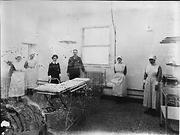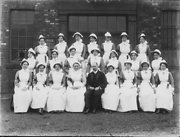 Hartlepool Sports & Leisure
Hartlepool Sports & Leisure
- Cinemas, Theatres & Dance Halls
- Musicians & Bands
- At the Seaside
- Parks & Gardens
- Caravans & Camping
- Sport
 Hartlepool Transport
Hartlepool Transport
- Airfields & Aircraft
- Railways
- Buses & Commercial Vehicles
- Cars & Motorbikes
- The Ferry
- Horse drawn vehicles
 A Potted History Of Hartlepool
A Potted History Of Hartlepool
- Unidentified images
- Sources of information
- Archaeology & Ancient History
- Local Government
- Printed Notices & Papers
- Aerial Photographs
- Events, Visitors & VIPs
 Hartlepool Trade & Industry
Hartlepool Trade & Industry
- Trade Fairs
- Local businesses
- Iron & Steel
- Shops & Shopping
- Fishing industry
- Farming & Rural Landscape
- Pubs, Clubs & Hotels
 Hartlepool Health & Education
Hartlepool Health & Education
- Schools & Colleges
- Hospitals & Workhouses
- Public Health & Utilities
- Ambulance Service
- Police Services
- Fire Services
 Hartlepool People
Hartlepool People
 Hartlepool Places
Hartlepool Places
 Hartlepool at War
Hartlepool at War
 Hartlepool Ships & Shipping
Hartlepool Ships & Shipping

Cameron Hospital
Details about Cameron Hospital
Cameron Hospital opened in 1905 as a General Hospital. In 1955 it became the Cameron Maternity & Gynaecology Hospital, closing in 1991 when services were transferred to Hartlepool General Hospital.
Location
Related items :
 Association of Friends of the Cameron Hospital
Association of Friends of the Cameron Hospital
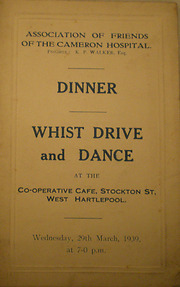 Donated by W Henderson
Donated by W HendersonPart of the Business Cards collection
Association of Friends of the Cameron Hospital Dinner, Whist Drive and Dance 1939. To take place in the Co-op Cafe, Stockton Street.
More detail » Cameron Hospital
Cameron Hospital
Cameron Hospital is usually remembered as a women’s hospital, but in fact it was built and equipped in 1905 as a general hospital, at a cost of £20,400.
It was a gift to the town by the Cameron Family and when it opened it provided 40 beds in one female and one male ward, and an operating theatre. A 20 bedded children’s ward was opened in 1931 as well as a veranda for the south ward. It became a training hospital in 1933.
In 1955 the focus of the hospital was altered and it became the Cameron Maternity and Gynaecology Hospital.
The hospital over the years became renowned for pioneering advances in medical and surgical techniques. The region’s first GIFT baby was a success story for consultant Hugh Dawson and his team in 1989 and the Cameron team also successfully carried out IVF on the N.H.S. in 1990 - only the second hospital in the country to be successful with an N.H.S. patient.
Cameron Hospital closed to the public in 1991 when the team was transferred to the General Hospital, Hartlepool.
More detail » Cameron Hospital 1925
Cameron Hospital 1925
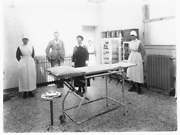 Donated by Douglas Ferriday
Donated by Douglas FerridayPart of the Hartlepool Library Service collection
View of Cameron Hospital from 1925. Another similar picture states that this is the operating theatre though it looks a little sparse for this to be true.
More detail » Cameron Hospital 1980s
Cameron Hospital 1980s
 Donated by Hartlepool Library Service
Donated by Hartlepool Library ServiceThe yellow Mk.III Ford escort on the left would suggest this view of Cameron Hospital was probably taken sometime in the 1980s or 1990s.
More detail » Cameron Hospital 1991 (1)
Cameron Hospital 1991 (1)
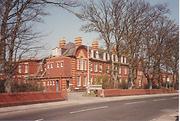 Donated by Hartlepool Library Service
Donated by Hartlepool Library ServiceDated 1991
A view of Cameron Hospital taken in April 1991.
More detail » Cameron Hospital 1991 (2)
Cameron Hospital 1991 (2)
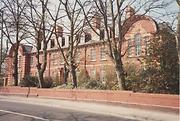 Donated by Hartlepool Library Service
Donated by Hartlepool Library ServiceDated 1991
A view of Cameron Hospital taken in April 1991.
More detail » Cameron Hospital 1991 (3)
Cameron Hospital 1991 (3)
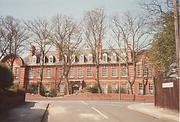 Donated by Hartlepool Library Service
Donated by Hartlepool Library ServiceDated 1991
A view of Cameron Hospital from Tunstall Grove, taken in April 1991.
More detail » Cameron Hospital Wooler Road
Cameron Hospital Wooler Road
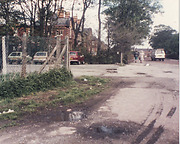 Donated by Doreen Holdforth
Donated by Doreen HoldforthCameron Hospital, Wooler Road, Hartlepool
More detail » Cameron Hospital as new
Cameron Hospital as new
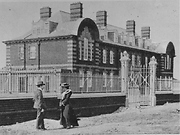 Donated by Hartlepool Library Service
Donated by Hartlepool Library ServiceA view of Cameron Hospital probably taken in 1905/06, as the the pavement and road in front of the building have yet to be constructed.
HHT+N 174
More detail » Cameron Hospital from the air
Cameron Hospital from the air
 Donated by Hartlepool Library Service
Donated by Hartlepool Library ServiceA shot of Cameron Hospital, Serpentine Road, Hartlepool, from the air. The building is almost centre to the picture.
More detail » Cameron Hospital in the early 1900s
Cameron Hospital in the early 1900s
 Donated by Hartlepool Library Service
Donated by Hartlepool Library ServiceA view of Cameron Hospital taken in the early 1900s, but before 1908.
More detail » Cameron, Colonel John William
Cameron, Colonel John William
John William Cameron was born in 1841 in Kirkby Stephen, Lancashire, although his family was of Scottish origin.
Before he came to West Hartlepool as a young man he had served his apprenticeship in the Brewery trade in Barnard Castle. It was also during his time at Barnard Castle that he became interested in things military and before he came to West Hartlepool he had been 5 years in the Volunteer Rifle Corps there. This interest he was to develop a great deal further in his new home.
He moved to West Hartlepool in 1865, at the age of 24 years to become head brewer at the Lion Brewery. The Brewery had been set up in 1852 when William Waldon bought up the land to build on. He was a newcomer to West Hartlepool, as were all the important figures in the early days. Waldon was elected as a Town Improvement Commissioner to serve on the first Board running the new town but he died before its first meeting, on 5th September 1854.
Waldon’s widow then ran the business until the eldest son was of age, in the period before Cameron’s arrival. William Waldon Junior does not seem to have been interested in the brewing business and he died young in 1872, after which Cameron agreed with the trustees to take over the business on a 21-year lease. He soon embarked on a 10-year programme of building and enlarging the premises, buying up more land near Stockton Street.
In 1893 he bought the brewery outright and made the business into a Limited Company. He then embarked on absorbing nearby competitors; he bought up Nixey, Coleclough & Baxter on the Headland and M. Rickinson & Company by 1895, so that he doubled his tied houses from 50 to 103.
His involvement in philanthropy and public works was extensive and his military activities also took much of his energy. He joined the Artillery Volunteers on coming to West Hartlepool and was a Sub-Lieutenant by 1871. By 1874 he had become Captain and in 1881 he became commander of the town’s Corps. In 1885 the Rifle & Artillery Volunteers amalgamated and he became Lieutenant Colonel. The 4th Durham Volunteers had a good reputation due to their record in National Shooting competitions and their smart turn out at local civic occasions.
His political career led to his being prominent in the history of the new town. In 1873 he was elected a Town Commissioner and he was to be on the Board for 14 years. Although he only became the chairman in 1886 it was in this period that the Town gained its Charter of Incorporation, largely due to his efforts.
At the first Municipal Elections he came top of the poll and was elected an Alderman, he did not become Mayor until 1889, letting Alderman William Gray and George Pyman take precedence. His brewery’s attractive head office “Greenbank” was the site of Stranton’s celebrations in 1887, the year of Victoria’s Jubilee and West Hartlepool’s Charter.
His last civic act was to offer the statue of the town’s founder, Ralph Ward Jackson, to West Hartlepool, in 1895. He wished it to be unveiled at the top of Church Street, where it stands today, and that it be unveiled in 1897, the 50th anniversary year of the opening of the West Dock. He himself died before the ceremony in 1896. Perhaps a more important monument to him was the Cameron Hospital, presented to the town by his family.
More detail » Children's Ward Cameron Hospital
Children's Ward Cameron Hospital
 Donated by Douglas Ferriday
Donated by Douglas FerridayPart of the Hartlepool Library Service collection
Dated 1932
This photograph shows Cameron's Hospital Children's Ward in 1932, a year after the department had opened. In that year an appeal had been launched by hospital president Sir William Gray, for funding because of unemployment in the town. The boy in the centre who had just had a mastoid operation was Harry Andrews who was also asked to 'fake' a broken leg and sore head and was shown sporting plaster cast, crutches and bandages in the highly successful appeal booklet. (see George Colley's Hartlepool Portrait book)
HHT+N 494
More detail » Christmas football at Cameron Hospital
Christmas football at Cameron Hospital
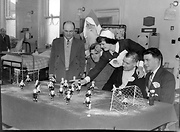 Created by NDM
Donated by Hartlepool Museum Service
Created by NDM
Donated by Hartlepool Museum ServicePeople enjoying table football at Christmas in the early 1950s. Judging by the patient in bed to the left, it appears to be on a female ward. Possibly Pools players watching ? Does anyone know?
More detail » Coronation Day
Coronation Day
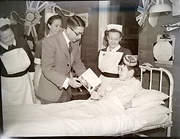 Created by NDM
Donated by Hartlepool Museum Service
Created by NDM
Donated by Hartlepool Museum ServiceDated 1953
A Cameron's Hospital patient is being presented with a Ladybird book about Queen Elizabeth in 1953.
Tim Evans from Bath has informed us that he believes the gentleman in the photograph to be Councillor Bill Coward.
More detail » Hospital operating theatre
Hospital operating theatre
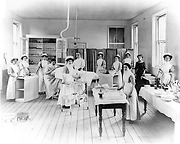 Donated by Hartlepool Library Service
Donated by Hartlepool Library ServiceHospital operating theatre along with staff and a patient. Probably Camerons.
HHT+N 484
More detail » Icy Car Park
Icy Car Park
 Created by unknown
Donated by Hartlepool Library Service
Created by unknown
Donated by Hartlepool Library ServiceA view of Cameron Hospital car park, sometime in the 1980s, with Serpentine Road looking very slippery!
More detail » In the Hospital grounds
In the Hospital grounds
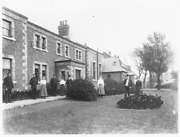 Donated by Douglas Ferriday
Donated by Douglas FerridayPart of the Hartlepool Library Service collection
Dated 1920
This photograph shows a group of people in the grounds of Cameron's Hospital circa 1920. Two of the men appear to be in Police uniform.
More detail » Men's Ward, Cameron Hospital
Men's Ward, Cameron Hospital
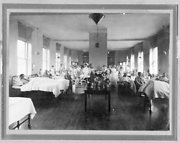 Donated by Hartlepool Museum Service
Donated by Hartlepool Museum ServiceTaken well before 1955 when the hospital became one for midwifery and gyneaocology as this is a men's ward.
More detail » Nurses at Cameron Hospital
Nurses at Cameron Hospital
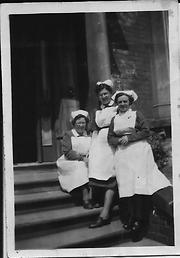 Donated by Jacky Armstrong
Donated by Jacky ArmstrongThree nurses on the steps of Cameron's Hospital.
More detail » Nurses at Cameron Hospital
Nurses at Cameron Hospital
 Donated by Doreen Holdforth
Donated by Doreen HoldforthNurses sitting outside on the veranda at Cameron Hospital, Hartlepool.
More detail » Nurses at Cameron Hospital
Nurses at Cameron Hospital
 Created by northern daily mail
Donated by Jacky Armstrong
Created by northern daily mail
Donated by Jacky ArmstrongProbably in the 1950s, the nurse on the right is Joan Hamerski (nee Bolton). The lodge behind the nurses still exists although the hospital on the left has made way for a housing development.
In the background are the houses in Hart Lane now obscured from this angle by the bungalows on Serpentine Bank.
More detail » Nurses at Cameron Hospital 2
Nurses at Cameron Hospital 2
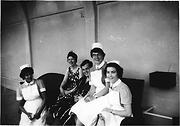 Donated by Jacky Armstrong
Donated by Jacky ArmstrongProbably taken inside the hospital in the 1950s. Joan Bolton is second from right.
More detail » Taking Tea with the Matron
Taking Tea with the Matron
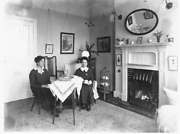 Donated by Douglas Ferriday
Donated by Douglas FerridayPart of the Hartlepool Library Service collection
Dated 1921
Taking tea in the Matron's room at Cameron's Hospital in 1921.
More detail »





